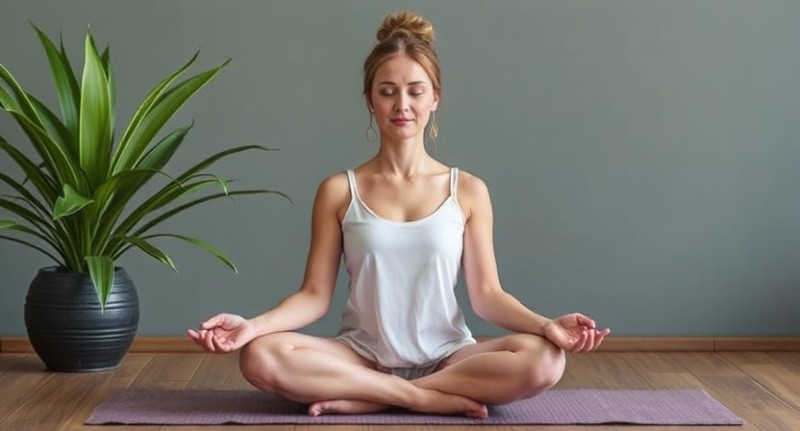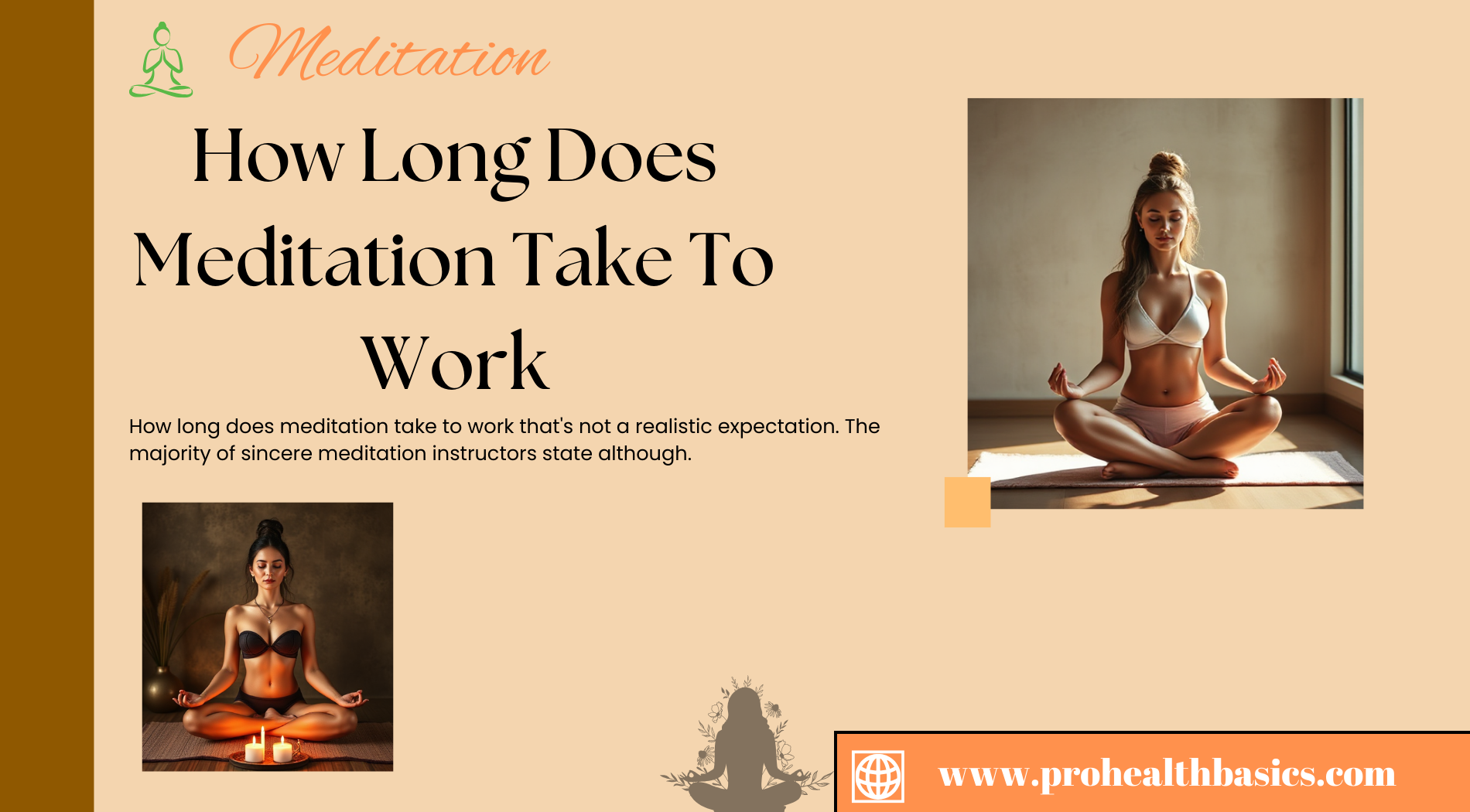Many novice meditators start sitting with the expectation that the all-encompassing advantages of meditation would become apparent after a few days. They anticipate that meditation will work as a temporary solution, similar to taking a painkiller. How long does meditation take to work that's not a realistic expectation. The majority of sincere meditation instructors state that although a lucky few beginners benefit right away, the rest of us must practice meditation consistently over time before we can see its positive effects.
For newcomers, we suggest trying meditation every day for a month before weighing the benefits and drawbacks. Continue for five or ten minutes each day, even if you feel like giving up sooner. There are several advantages to meditation, all of which may be attained gradually. Don't undervalue yourself.
Is 10 Minutes Enough Time for Meditation?

Your own objectives and meditation technique will determine what is sufficient for you. For instance, some studies indicate that 10 minutes a day is sufficient to provide notable advantages if you're a novice or your primary objective is stress reduction.
OneOn the other hand, daily 45-minute sessions of mindfulness-based stress reduction (MBSR) meditation have been found to be beneficial for anxiety. In the end, the length of your session should be whatever suits you.
But if you want to focus on improving your attention and concentration, 30 minutes a day allows you to practice breathing methods while stretching lightly. Do meditation every day, whether it takes ten or forty-five minutes. Studies have shown that in order to get the advantages of meditation, consistency is more crucial than the length of a session.
Read also: Try This Mindfulness Practice When You Feel Stuck
How Often Should You Meditate Each Day?
Practice regular meditation at least once a day. Try breaking up larger sessions into many smaller ones if you're going toward them but are having trouble with them.
When Is the Right Time to Meditate?
It may take some trial and error to determine the ideal time of day to meditate, but start by taking your schedule and other variables that are the least unpredictable into account.
Consider the times when you are most likely to follow your program. For two reasons, morning meditation is preferred by certain people. Prioritizing self-care and mindfulness throughout the day ensures that nothing will disrupt your routine and provides you with the mental space you need to be ready for the day.
However, meditating at night may help you balance out the day's barrage of information in the silence.
What kinds of meditation are there? (How Long Does Meditation Take To Work)
The process of consciously examining your thoughts, emotions, and physical sensations while maintaining an attitude of acceptance and mindfulness is known as meditation.
Meditation may be done in a variety of ways, and since it's such a personal practice, you can adapt it to fit your needs. The following methods have been extensively studied in scientific studies:
-
Mindful meditation or focused focus: involves focusing on a single item, such as your breathing, a bodily experience, or an external object. Focusing intently on a single thing and returning your attention to it when your thoughts stray is the aim of this kind of meditation.
-
Meditation under open view: involves focusing on everything that is happening in the moment and just observing it without responding.
11 Strategies to Reduce Stress
1. Place Stress in the Right Place

Life will inevitably include stress. Your mental and physical states are impacted by how you handle it. Here are some relaxing techniques you may do immediately to reduce stress and enter a less tense state. The next time you're searching for a method to reduce stress, try one of these techniques.
2. Move (How Long Does Meditation Take To Work)
There are several ways that exercise improves mood. Engaging in physical activity helps you forget about your daily concerns. It also releases endorphins, which improve mood. Exercise of any kind lowers tension and anxiety, whether you choose to work out at the gym or go for lengthy walks.
Read also: Mindfulness Meditation for Beginners
3. Inform a Friend
One of the biggest stress relievers is social support. When you're feeling anxious, get together with friends or family. Seek out others who are facing similar difficulties. You'll feel less alone if you talk about your experiences with others who can really relate.
4. Put Your Stress in Writing
Are you under stress? You might find answers you hadn't previously considered and feel more at ease when you write about your issues in a diary. Writing in a notebook, a computer file, or even an app on your phone can help you reap these advantages. To get the most out of it, simply be truthful about how you feel.
-
How to reduce school-related stress
-
How can I quit eating while I'm stressed?
-
How to reduce excessive stress
-
How to prevent weight gain due to stress
-
How to stop weeping while under stress
-
Ways to reduce your anxiety about everything
5. Treat yourself with kindness. (How Long Does Meditation Take To Work)
Everybody has an internal conversation going on. We don't always talk to ourselves in a comforting, friendly manner. Gaining proficiency in the art of kind and constructive self-talk helps keep you composed and facilitates the generation of workable answers to issues.
Consider how you would talk to a buddy who was going through a similar scenario when you were faced with a difficulty or distressing circumstance. It's much more comforting to tell oneself, I can work this out, or, It'll be OK, than to catastrophize or talk negatively to yourself.
Try talking to yourself the way you would a concerned friend in need the next time you're wondering how to stop feeling so anxious.
6. Take a Breath Break

One method for rapidly halting the stress reaction is to practice breathing techniques. Breathing exercises have two relaxing effects. Concentrating on the breath prevents the body's "fight or flight" reaction and diverts attention from stressful and scary thoughts.
Take calm, deep breaths through your nose to complete the workout. Give your abdomen and chest room to fill with air. For as long as it took you to inhale, slowly exhale while repeating a word or phrase that helps you feel at ease. Spending at least ten minutes on breathing exercises will yield the biggest advantages.
7. Pay Attention (How Long Does Meditation Take To Work)
Music can help you stay calm if you have to deliver a speech at work or are going through a similar stressful situation. In one research study, participants who listened to Gregorio Allegri's Miserere, a Latin choral piece, had lower levels of the stress hormone cortisol than those who just heard the sound of rippling water. One of the simplest methods to reduce stress is to listen to relaxing music.
Read also: Interested in Meditation? Here Are the Basics
8. Take a whiff of lavender.
Are you unsure of how to reduce stress at work? Grab some lavender. The relaxation response can be triggered by certain scents. In one research study, nurses' stress levels were compared to those of nurses without lavender oil vials pinned to their clothing.
Compared to nurses who were smell-free, those who were exposed to lavender aroma reported feeling more at ease. Lavender can intensify the effects of pain relievers and anxiety medications. If you use any of these drugs, make sure to consult your doctor before taking lavender oil. Additionally, lavender essential oil may aid with migraines and stress-related headaches.
9. Wear a Genuine Smile
Put an end to your anxiety and grin! Something is true of the ancient saying, "Grin and bear it." When you smile, your facial muscles tense up a little, which helps you feel less anxious. Genuine smiles, which use the muscles surrounding the lips and eyes, are very effective at relieving tension. After a stressful event is ended, smiling might also hasten the recovery of a raised heart rate.
10. Step Outside (How Long Does Meditation Take To Work)
Are you wondering how to reduce your stress levels? Step outdoors. An excellent way to reduce stress is to spend time outside. According to studies, even a little time spent outside near home might improve one's attitude. In addition to promoting relaxation, going outside frequently entails being active.
11. Release the gum bubble
Do you feel like you're losing your mind? Take out a piece of gum. Chewing gum may help reduce tension and anxiety, according to research. It's possible that chewing's regular motion increases blood flow to the brain.
According to a different idea, the relaxation response is triggered by the gum's flavor and aroma. The next time you find yourself thinking, "I can't stop stressing," reach for a stick of gum. It's a cheap, efficient, and almost anywhere stress-relieving method.
Unexpected Food Combinations for Strong Flavor
1. Mango and Jicama

A staple of Latin America, jicama is light and crisp and has a flavor similar to that of an apple or pear. Kasper combines it with mango and adds lime and chile pepper to make a Mexican-inspired snack.
Two ripe mangoes and jicama should be peeled and chopped into thin sticks. Season with salt, chili powder, and lime juice on all sides. Together with the mango's sweetness, the lime's acidity serves to temper the heat from the chile.
2. Slices of raw onion, tamed (How Long Does Meditation Take To Work)
Slice a red onion thinly and place it in a bowl with 1½ parts sugar and 1 part salt to soften its strong flavor. Keep in the fridge all night. Kasper slides these onions on top of sandwiches and burgers and adds them to salads. To make a two-minute onion sweetener, put chopped or sliced onions in a dish, add vinegar, and microwave for two to three minutes.
3. Fruit, Ricotta, and Rosemary
This dessert pizza combines mild cheese, savory herbs, and sweet summer fruits. On a pizza pan, bake the pastry dough until golden brown, then let it cool. Add 1 cup of mascarpone, sweetened to taste, and 15 ounces of ricotta.
Add melon, cherries, plums, nectarines, berries, and cherries on top. Add sugar, black pepper, basil, and rosemary. Drizzle half a lemon over the garnishes.
Read also: How To Practice Mindful Meditation
4. Fresh Lemon, Feta, and Olive Oil
This triad of flavors is typical of Eastern Mediterranean cuisine. The reason it works so well, according to Kasper, is because the flavors of the fruity olive oil, the salty and creamy feta cheese, and the acidic zing of fresh lemon juice all complement one another wonderfully.
She, like them, pored over a bed of romaine lettuce after they had been blended together. This creamy feta dressing might add some flair to a salad of chopped watermelon and radish for a daring diner.
5. Watermelon and radishes (How Long Does Meditation Take To Work)
Kasper describes this peculiar culinary duo as the watermelon doing a waltz and the radish doing a tap dance. The fresh watermelon sweetness and lightness are counterbalanced with the bitter radish flavor.
Chop the twosome and mix with salt, pepper, and a bit of lemon or lime juice to make a summer salad or salsa. For an additional flavor accent, you can add red onions and substitute red wine vinegar for the citrus juice.
Which Foods Are Best for Your Diet and Health Because They Are High in Calcium
1. Molasses, pudding, and frozen foods

A lot of the abovementioned foods may be combined to create delicious meals that are high in calcium. Both frozen mac and cheese and frozen cheese pizza are excellent providers of calcium, but they also frequently include high levels of fat, cholesterol, and calories. Additionally, look for methods to boost calcium intake without consuming excessive quantities of fat.
2. Seeds and Nuts
Nuts are also an excellent source of calcium and protein. Eat additional sunflower seeds, sesame seeds, and almonds to increase your intake of calcium. Nuts and seeds may be incorporated into a variety of dishes and make excellent snacks. Try incorporating them into your next salad or cup of oats.
3. Legume (How Long Does Meditation Take To Work)
Soybeans, baked beans, black-eyed peas, black beans, dried beans, garbanzo beans, kidney beans, navy beans, and white beans are common legumes that are high in calcium.
Because they provide a significant amount of protein in addition to calcium, legumes are essential in vegan or vegetarian diets.
Beans can be used as the primary protein in a meal or added to soups, chilies, and stews. The next time you need a healthy snack, you can even consume a side of edamame.
4. Grains
Calcium is abundant in whole grains. Quinoa, brown rice, corn tortillas, and wheat bread may all provide a substantial foundation for meals. Foods high in calcium include canned salmon sandwiches, rice and vegetable stir-fries, and quesadillas with cheddar cheese.
5. Foods Fortified (How Long Does Meditation Take To Work)
Fortified food is defined as food that has been enhanced with additional nutrients or nutrients that aren't found naturally.
Almond, rice, or soy milk fruit juices tofu frozen waffles oatmeal English muffins and cereal are examples of common foods fortified with additional calcium. Make sure your food has been fortified with the calcium you need by always reading the label.
Many breakfast alternatives use foods that have been fortified. You may boost your calcium intake by starting your day with waffles with a side of juice, toast, or porridge with almond milk.
Five Delectable Recipes High in Calcium
1. Dill-sauced salmon croquettes

A tasty method to increase your calcium intake is by eating salmon croquettes. Additionally, canned salmon has 10–20 times the calcium content of fillets. Make two cakes with nonfat Greek yogurt and a creamy dill sauce to get 425 mg of calcium.
2. Chicken Stuffed with Sesame
Do you want to add more calcium to your regular chicken dinner? Stuff a chicken breast with spinach and a mixture of creamy ricotta cheese. Season, sprinkle with sesame seeds, and bake. About 25% of your daily calcium needs are met by one serving, which contains 251 mg.
3. Cake with almonds (How Long Does Meditation Take To Work)
In place of wheat flour, finely ground almonds are used to make this delicacy. The almonds add a little calcium, and their delicate flavor counterbalances the sweetness and citrus zest. For about 110 mg of calcium per serving, add a low-fat lemon cream cheese icing.
4. Mousse with Chocolate
One delightful approach to help fulfill your calcium needs is with this very creamy treat. The recipe calls for little amounts of milk, eggs, and chocolate, which add up to 100 mg of calcium every half cup.
Try the lower-fat varieties of chocolate mousse that are available in many stores if you're craving it but don't want to consume the full amount of calories, fat, and cholesterol.
Read also: Interested in Meditation? Here Are the Basics
5. Grape Leaves Stuffed (How Long Does Meditation Take To Work)
Greeks are known for their stuffed grape leaves. Typically, they are prepared with ground beef, rice, flavorful herbs and spices, and grapevine leaves.
The calcium content of the olive-green leaves is increased by dipping them in nonfat Greek yogurt. The total calcium content of six filled leaves and 1/4 cup of yogurt sauce is 147 mg, or 15% of the daily need for most persons.
Conclusion on How Long Does Meditation Take To Work
The results of meditation differ for each individual based on a variety of factors such as personal mentality, technique, and consistency. After only one session, some people report feeling instantly relaxed, but after a few weeks of consistent practice, deeper benefits like more focus, less tension, and emotional balance usually become clear.
According to scientific research, daily meditation can result in visible changes in mental health and brain function in as little as four to eight weeks. But over the course of months or even years, long-term practitioners often see major changes. In the end, meditation is a process rather than an end-all.
Patience and constancy are crucial. You may develop awareness and slowly gain the benefits of meditation by including it in your everyday practice. Whatever your goals—spiritual growth, mental clarity, or stress relief—it's crucial to get started and keep going.
FAQs: How Long Does Meditation Take to Work?
How long does it take to get benefits from meditation?
According to studies, meditation should be practiced for eight weeks to notice effects. One research study found that 8 weeks of 13 minutes a day of meditation improved mood, memory, and emotional control. However, there isn't a secret number.
How do you know when meditation is working?
While each person's symptoms of meditation effectiveness are unique, frequent ones include heightened self-awareness, enhanced attention, greater emotional control, and less stress. Meditation also makes it easier for you to deal with stressful situations and gives you a greater sense of serenity in your day-to-day activities.
What happens after 2 weeks of meditation? (How Long Does Meditation Take To Work)
In a 2019 study, 153 persons who spent two weeks using a mindfulness meditation app reported feeling less alone and having more social interactions than those in a control group.
What happens after 40 days of meditation? (How Long Does Meditation Take To Work)
At the conclusion of the 40 days, I felt a sense of success at having completed what I had begun, a nice night's sleep at last, and hundreds of dollars spent on vitamins and herbal tinctures designed to heal my adrenals and liver.
What is the success rate of meditation? (How Long Does Meditation Take To Work)
Many respondents said that meditation improved their emotional well-being (86.9%), reduced stress or helped them relax (89.4%), improved their general health and well-being (79.0%), and/or improved their sleep (69.3%) (Table 3).


.jpg)



